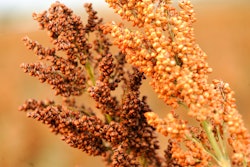
The emergence of new herbicides poses a threat to the productivity and resilience of corn crops. In a recent study, a team of Agricultural Research Service (ARS), university, and industry scientists discovered a new genetic vulnerability to the herbicide tolpyralate in 49 varieties of corn. This finding marks the first report of tolpyralate posing a danger to corn and highlights the importance of understanding and addressing these vulnerabilities to protect crop yields.
Tolpyralate is a post-emergent herbicide that belongs to a class of herbicides known as HPPD inhibitors. When applied, tolpyralate triggers a biochemical chain of events in targeted weeds, leading to bleached-appearing leaves and ultimately plant death. Typically, corn plants can metabolize HPPD inhibitors before they cause harm. However, this new research reveals that certain corn varieties are susceptible to tolpyralate damage due to a genetic vulnerability.
Corn breeders often evaluate new candidate varieties by spraying them with nicosulfuron, an ALS-inhibiting herbicide. This test helps determine a variety's sensitivity to various post-emergence herbicides, including most ALS and HPPD inhibitors. However, the researchers discovered that spraying nicosulfuron does not reliably indicate corn tolerance to tolpyralate.
The team, led by Marty Williams, an ecologist with the ARS Global Change and Photosynthesis Research Unit, conducted extensive greenhouse, field, and laboratory tests to investigate this genetic vulnerability. They traced the sensitivity to a cluster of genes residing on a unique region of chromosome 5. This finding was confirmed by observing visible tolpyralate damage in offspring plants derived from crosses between the vulnerable sweet corn inbred line XSEN187 and two tolerant corn lines.
Extent of Tolpyralate Sensitivity
The scope of the investigation expanded beyond the initial discovery, revealing tolpyralate sensitivity in a total of six types of field corn and 43 types of sweet corn. Further screening is likely to identify the vulnerability in additional corn varieties. Notably, the widely popular sugary enhancer gene, introduced to sweet corn through the inbred line IL677a, was found to be severely sensitive to tolpyralate. This raises concerns about the widespread introduction of this vulnerability alongside the desirable sugar enhancer trait.
The researchers also observed that tolpyralate sensitivity in the evaluated corn lines is contingent upon exposure to oil-based adjuvants. Adjuvants are additives mixed into herbicide tanks to ensure better absorption into the leaves of targeted weeds, enhancing the herbicide's effectiveness. While removing adjuvants is not a viable option, it is crucial to understand how these gene clusters on chromosome 5 make the corn varieties vulnerable to tolpyralate.
Implications for Crop Injury and Risk Mitigation
The discovery of this new genetic vulnerability to tolpyralate in corn has significant implications for crop injury and risk mitigation. Understanding the physiological mechanisms behind the vulnerability can help manufacturers and seed companies develop strategies to reduce the risk of crop damage. Improving crop tolerance to the herbicide and exploring alternative weed control methods can safeguard corn yields and protect farmers from significant losses.
Moreover, the research on this genetic vulnerability may have broader applications beyond tolpyralate. Several new HPPD-inhibiting herbicides are being developed using the same pyrazole ring scaffold as tolpyralate. By gaining a greater understanding of the physiological mechanisms, scientists can anticipate and address potential vulnerabilities in future herbicide developments.


















